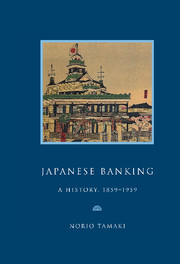Book contents
- Frontmatter
- Contents
- Preface
- Genealogy of leading Japanese banks, 1859–1959
- List of abbreviations
- Map
- Part I A bankrupt Shogunate, 1859–1868
- Part II The Meiji Restoration: monetary confusion and banking experiments, 1868–1881
- Part III Matsukata, the wizard of Japanese banking, 1881–1897; the Yokohama Specie Bank (1880) and the Bank of Japan (1882)
- Historical background
- 9 The Bank of Japan, or Nichigin, 1881–1897
- 10 The Yokohama Specie Bank, or Shokin, 1882–1897
- 11 Consolidation and expansion, 1883–1897
- 12 The adoption of the gold standard, 1893–1897
- Part IV The Japanese on the London money market, 1897–1911
- Part V War, the Japanese boom years, 1911–1919
- Part VI Crisis and the road to war, 1919–1937
- Part VII Complete commitment, struggle and defeat, 1937–1945
- Part VIII American ‘democratisation’ and the search for growth, 1945–1959
- An extraordinary century, 1859–1959
- Appendices
- Notes
- Bibliography
- Index
12 - The adoption of the gold standard, 1893–1897
Published online by Cambridge University Press: 03 February 2010
- Frontmatter
- Contents
- Preface
- Genealogy of leading Japanese banks, 1859–1959
- List of abbreviations
- Map
- Part I A bankrupt Shogunate, 1859–1868
- Part II The Meiji Restoration: monetary confusion and banking experiments, 1868–1881
- Part III Matsukata, the wizard of Japanese banking, 1881–1897; the Yokohama Specie Bank (1880) and the Bank of Japan (1882)
- Historical background
- 9 The Bank of Japan, or Nichigin, 1881–1897
- 10 The Yokohama Specie Bank, or Shokin, 1882–1897
- 11 Consolidation and expansion, 1883–1897
- 12 The adoption of the gold standard, 1893–1897
- Part IV The Japanese on the London money market, 1897–1911
- Part V War, the Japanese boom years, 1911–1919
- Part VI Crisis and the road to war, 1919–1937
- Part VII Complete commitment, struggle and defeat, 1937–1945
- Part VIII American ‘democratisation’ and the search for growth, 1945–1959
- An extraordinary century, 1859–1959
- Appendices
- Notes
- Bibliography
- Index
Summary
Two incidents in the early 1890s, which were apparently unrelated, exerted pressure on Japan to adopt the gold standard. In the autumn of 1893, India, the largest silver standard country in the world, abandoned silver and made gold her standard metal. The Indian preference for gold was in response to the world trend. Germany was able to adopt the gold standard in 1871 following the gold indemnity obtained from France after the Franco-German War. The bimetallic Latin Monetary Union, composed of France, Italy, Belgium, Switzerland and Greece, fell apart in 1878. These two incidents were probably exactly what Masayoshi Matsukata anticipated when he was in France listening to French Finance Minister Say. Silver, as a financial standard, was judged increasingly risky because its declining value was far faster and greater than that of compensating price rises. An alternative to the silver standard, that is a dual gold and silver standard, did not offer any solution. Indeed, having to juggle the values of two metals led to the nightmare of continuous adjustment. There was another great merit to the adoption of the gold standard. London was the sole international monetary centre which could supply resources to any countries accessible to the market, albeit on the gold standard basis. In order to tap money from this unequalled money market, the gold standard was a necessary prerequisite. The Indian departure from silver, therefore, was more than a great shock to the Japanese.
In October 1893, immediately in the wake of the Indian action, the Japanese government appointed a Monetary Commission.
- Type
- Chapter
- Information
- Japanese BankingA History, 1859–1959, pp. 82 - 86Publisher: Cambridge University PressPrint publication year: 1995



